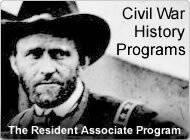
Seminar Review--The Critical Role of Women in the Civil War
The Smithsonian Associates Civil War E-Mail Newsletter, Volume 2, Number 10
It was clear at this seminar that Professor Smith holds women of the Civil War in great regard. He opened by saying that, the Civil War was the war of the women. The times held more opportunities to recognize women and allowed women to take on politically active roles.
He put women and war in historical context, going back to the Greco-Roman era, where a mother sending her son off to war told him to, "Return with your shield, or upon it!" In other words, he was expected to be victorious or to die in the effort. This sentiment resounded in the South, where they were inspired by the values in Sir Walter Scott's Ivanhoe.
The South embraced the ideal of a romantic, chivalric master ruling class. These images were superimposed on their society and they lived it. This translated into the exaltation of the role of woman, with man's role being to fight for her honor. The upper classes saw themselves in these terms and the lower classes aspired to it. This is why William Tecumseh Sherman said that the real warriors of the South were the women, who encouraged the men to fight. Thus, Sherman turned the war against civilians--the women at the home front.
Dr. Smith explains that in addition to the women on both sides who gave their sons, husbands, and fathers to the war effort, some women gave their spirit. Harriet Beecher Stowe started the war with Uncle Tom's Cabin. With the words to the Battle Hymn of the Republic, Julia Ward Howe defined the purpose of the war--"to make men free" (we assume she meant women too!). Clara Barton mended the wounds of war by nursing men on the battlefields; and, her post-war projects to find missing soldiers, and to identify and bury the victims of Andersonville. During this time the Capitol dome was completed and the Statue of Freedom was placed on top--a female figure symbolizing both the victory of freedom and the continuity of the Union. This action served to consecrate the war.
Dr. Smith mentioned other women whose contributions to the era are often overlooked. These include the Southern diarist Mary Chestnut; Phoebe Pemberton, head of Chimborazo Hospital in Richmond; Harriet Tubman, conductor of the Underground Railroad; and, Sojourner Truth, who fought for emancipation and women's rights.
The seminar provided me with a great deal of new information. And, I was very pleased with the choice of Professor Smith to teach the class. He was a former speechwriter for President Carter and is a professor of history at American University, in addition to being a regular Smithsonian seminar and study tour leader. He was excellent, so was the topic, so was the information, and so was the evening spent at the Smithsonian.

Our thanks to Sara Bartlett for this review. Ms. Bartlett and her family recently moved to the Washington DC area and they just discovered the opportunities available as Smithsonian Resident Associate Program members. This fits in perfectly with Sara's career as an actor, writer, and independent scholar. This topic was especially meaningful to her, since she is also a Civil War re-enactor who portrays Clara Barton.

